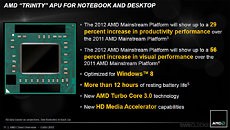- Joined
- Oct 9, 2007
- Messages
- 47,783 (7.41/day)
- Location
- Dublin, Ireland
| System Name | RBMK-1000 |
|---|---|
| Processor | AMD Ryzen 7 5700G |
| Motherboard | Gigabyte B550 AORUS Elite V2 |
| Cooling | DeepCool Gammax L240 V2 |
| Memory | 2x 16GB DDR4-3200 |
| Video Card(s) | Galax RTX 4070 Ti EX |
| Storage | Samsung 990 1TB |
| Display(s) | BenQ 1440p 60 Hz 27-inch |
| Case | Corsair Carbide 100R |
| Audio Device(s) | ASUS SupremeFX S1220A |
| Power Supply | Cooler Master MWE Gold 650W |
| Mouse | ASUS ROG Strix Impact |
| Keyboard | Gamdias Hermes E2 |
| Software | Windows 11 Pro |
A marketing slide by AMD for industry partners, which sums up what the company's 2012 Mainstream Platform led by "Trinity" APUs will offer, got leaked to the web. In it, AMD claims its next-generation APUs to offer up to 29 percent higher productivity performance (read: CPU performance), and up to 56 percent higher visual performance, compared to current-generation (Llano). At least the graphics performance figures seem to be consistent with early test results.
Apart from these, the slide claims Trinity to be optimized for Windows 8 (with AVX, AES-NI, SSE4.2, and DirectX 11.1 graphics, it could very well be). The processor is said to feature third-generation auto-overclocking technology, TurboCore 3.0. The mobile version of the chip will be designed to offer over 12 hours of resting battery-life. Lastly, there's mention of new media-acceleration features. AMD is expected to launch its new line of APUs in this quarter (before July).

View at TechPowerUp Main Site
Apart from these, the slide claims Trinity to be optimized for Windows 8 (with AVX, AES-NI, SSE4.2, and DirectX 11.1 graphics, it could very well be). The processor is said to feature third-generation auto-overclocking technology, TurboCore 3.0. The mobile version of the chip will be designed to offer over 12 hours of resting battery-life. Lastly, there's mention of new media-acceleration features. AMD is expected to launch its new line of APUs in this quarter (before July).

View at TechPowerUp Main Site





 . If not, i7 Qosmio ftw!
. If not, i7 Qosmio ftw!
